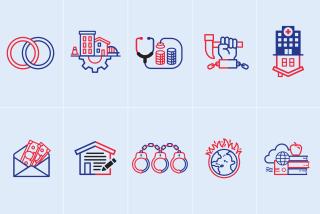ELECTION AFTERMATH GAS TAX : Supporters, Foes of 710 Extension Claiming Victory
- Share via
Supporters of the Long Beach Freeway extension interpret last week’s passage of three transportation ballot measures as a victory. But so do opponents of the controversial roadway project.
By late last week, it wasn’t clear which group really had won. And, as has long been the case with the top transportation issue in the western San Gabriel Valley--an issue that has gone national since South Pasadena was named an endangered place by the National Trust for Historic Preservation last year--it also wasn’t clear when it would become clear.
Freeway opponents as well as supporters will benefit from one project to be funded by the ballot measures, said Terry James, Alhambra Department of Public Works director. Alhambra’s Fremont Avenue, a major route used by travelers heading to and from the northern end of the Long Beach Freeway, will be widened from Valley Boulevard to Mission Road, James said.
Alhambra officials, who have argued for the proposed 6.2-mile extension from the San Bernardino Freeway in Los Angeles north to the Foothill Freeway in Pasadena, were pleased by the success of the transportation measures, including a gasoline tax increase to fund road and bridge projects. “Needless to say, we’re ecstatic,” James said.
Jerry Baxter, Caltrans district director for Los Angeles and Ventura counties, said Proposition 111 means the Long Beach Freeway extension “now becomes a real possibility.”
But Ralph Ochoa, a Sacramento lobbyist leading South Pasadena’s fight against the extension, said the freeway supporters are mistaken.
Proposition 111, Ochoa said, did contain provisions for financing ways to reduce traffic. “But there isn’t money set aside for the (Long Beach Freeway),” Ochoa said. “That’s an oversimplification, but it’s accurate.”
Regardless of whether money is now available for the project, South Pasadena leaders say their decades-old cause will prevail. “Our objections are so valid and so strong,” said Alva Lee Arnold, chairman of Citizens United to Save South Pasadena.
South Pasadena Mayor Evelyn Fierro agreed. “Historical preservation factors and environmental factors are going to balance any calls for a freeway,” she said. “It doesn’t matter the amount of money involved. I personally don’t feel we have anything to fear from passage” of the transportation ballot measures.
For months, state and federal transportation officials have said they would decide soon on the freeway project. Officials have been reviewing the environmental impacts of the so-called Meridian Route variation, which would go through the center of South Pasadena.
But last fall’s Bay Area earthquake meant extensive road and bridge repairs were needed in Northern California and less money was available for projects such as the freeway extension. The earthquake also drew attention to the overall deterioration of state roads and bridges.
Baxter said last week that the Long Beach Freeway extension remains a priority, and he expects a decision in the next two months.
The South Pasadena City Council, which has maintained that a freeway extension would destroy the community, took no formal position on the transportation ballot measures--Propositions 108, 111 and 116.
Voters in Alhambra and Pasadena, as well as South Pasadena, gave strong support to all three measures. The widest margin of support came from Pasadena.
South Pasadena community leaders say the ballot measures should help their cause by providing money for alternatives to roadways, such as commuter rail and light-rail trains.
“There have to be alternative solutions,” said Arnold. “That’s why we’re so enthusiastic about rapid transit, monorail and things like that, which would take people off the freeways.”
Los Angeles County and state transportation planners say that commuter rail trains planned for existing rail lines from San Bernardino to Los Angeles are among the projects with the highest priority to be aided by the ballot measures. County transportation commission Executive Director Neil Peterson has said those trains could begin service within the next two years.
In addition, another priority is light-rail commuter trains from Pasadena to Los Angeles, with work on the project now scheduled to begin in 1993.
Besides these rail projects, transportation planners say several major road improvements will be undertaken in the San Gabriel Valley in the next few years, aided by the money derived from the ballot measures:
* Car-pool and bus lanes for the Foothill Freeway throughout the San Gabriel Valley.
* Extension of the El Monte busway and car-pool lanes on the San Bernardino Freeway.
* Widening of a portion of the San Bernardino Freeway between the 605 Freeway and Puente Avenue.
* Addition of a truck lane on the Pomona Freeway in Diamond Bar.
* Improvements to Route 30 along Base Line Road from the Foothill Freeway to the San Bernardino County line.
PROP. 111 FUNDS
Proposition 111 will generate revenues that San Gabriel Valley cities and unincorporated Los Angeles County areas can use for improving and maintaining roads and streets. These are the yearly estimates to be allocated, based on population, to San Gabriel Valley cities.
Alhambra: $517,000
Arcadia: $346,000
Azusa: $264,000
Baldwin Park: $443,000
Bradbury: $6,000
Claremont: $256,000
Covina: $304,000
Diamond Bar: $435,000
Duarte: $149,000
El Monte: $659,000
Glendora: $337,000
Industry: $3,000
Irwindale: $8,000
La Puente: $236,000
La Verne: $211,000
Monrovia: $238,000
Monterey Park: $448,000
Pasadena: $926,000
Pomona: $836,000
Rosemead: $333,000
San Dimas: $223,000
San Gabriel: $241,000
San Marino: $98,000
Sierra Madre: $79,000
South El Monte: $132,000
South Pasadena: $171,000
Temple City: $226,000
Walnut: $175,000
West Covina: $661,000
Source: Los Angeles County
Transportation Commission
More to Read
Sign up for Essential California
The most important California stories and recommendations in your inbox every morning.
You may occasionally receive promotional content from the Los Angeles Times.










